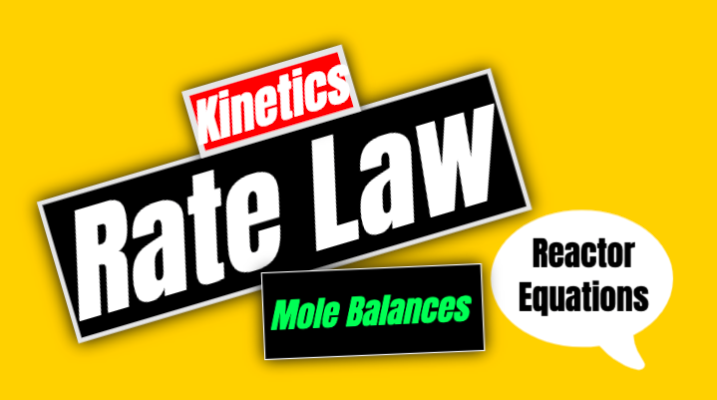In today’s post, we will be discussing the following:
1. What is the rate of a chemical reaction, how is it denoted? How do we find the https://www.merlinsilk.com/neologism/ rate law when given a chemical equation, and what is the Purchase Tramadol order of the equation?
2. Concentration, Molar, Flow Profiles
3. How to do mole balances on a system volume
4. Different types of reactors and their mole balances (also known as their Tramadol Prescription Online design equations).
https://drcarlosarzabe.com/dr-carlos-arzabe/ Rate, Order, Rate Law of a Chemical Equation
The rate (r) of a chemical equation is the amount of moles produced or consumed per unit time and volume, such as units of moles/liter*seconds. It is usually found per chemical compound in an equation, and can be positive or negative depending on if that compound is produced or consumed in the reaction. We usually denote the rate of each compound with a subscript for the name of that compound. For example, if we find the rate of chemical A, we will call it r with a subscript of a (written in the rate law below in green). To learn how to solve for rates based on a given chemical equation, see the video above.
The rate law is an equation that can be made for an entire chemical reaction. The general rate law for reactant A going to B can be found by the following equation, where -Ra is the rate of the first reactant, usually considered to be “A” (and negative because reactants are consumed) in units of mols/volume*time, k is the rate constant (units of this will vary depending on the units of concentration which change based on the exponent we have on them), and Ca is the concentration of reactant A, in units of mol/volume, such as mol/liter.

Note: You can find the rate of each compound once you find the rate of A, by equating the rates (see the video above). You also need to make sure the coefficients in front of each reactant become exponents on the concentration. See the example below for how to make the rate law when there are 3 reactants. The order of a reaction is the sum of the exponents on the concentration – in this case it is 8 (1+3+4 =8).

Concentration, Molar, Flow Profiles
We can make concentration profiles, molar profiles or flow profiles for reactants or products. All three of these graphs have a similar trend, with the graphs for the products being inverse to those of the reactants. If we think of a reaction where A is the reactant and B is the product, the concentration, flow rate, and moles of A will be very high at the beginning, when it is just being poured into the reactor. Once it begins to transform into product B, all of these variables will exponentially decrease over time. The opposite will happen for B, with the graph starting at 0 and going the other way around. You can see the similar trend in all of these graphs below:

Mole Balances
We can do a mole balance over a system volume (which is the boundary inside which the reaction occurs, like a reactor) by the following equation (note that all units are in moles/time). When we have a system at stady state, note that the accumulation term becomes 0, because Nj is not going to change with time as it does in an unsteady state system, where we would differentiate the moles of chemical j per unit time (that’s why there a dNj/dt in the equation only for that variable). I explain this more in the video above.

Reactors and Design Equations
Different types of reactors have different mole balances, also known as design equations. The types of reactors that are commonly used in this course are the following, and can be either continuous or non-continuous reactors:
(a) Batch Reactors
This is a non-continuous reactor. It is usually used with making expensive batches of a chemical or trying out a new process. It runs in an unsteady state. and nothing flows into or out of the reactor.
(b) Semibatch Reactors
This is partly continuous, partly non-continuous. This reactor is used to increase selectivity for desired products. It also runs in an unsteady state, and reactants/products are intermittently added/removed, which is in-between that of a batch and continuous reactor.
(c) Continuous Stirred Tank Reactors/Vat/Backmix Reactor
This is a continuous reactor, usually used with liquid phase (homogeneous) reactions. Products are flowing into and out of the reactor, and it runs at steady state (which means the accumulation term in the mole balance=0). We also assume perfect mixing, which means variables such as concentration or rate of reaction are uniform and don’t change with position within the system volume.
(d) Plug Flow/Tubular Reactor (PFR)
This is a continuous reactor, usually used with gas phase (homogeneous) reactions. Products are flowing into and out of the reactor, and it runs at steady state (which means the accumulation term in the mole balance=0). We also assume perfect mixing, which means variables such as concentration or rate of reaction are uniform and don’t change with position within the system volume. Concentration and reaction rate vary in the axial, or x, direction (the direction of liquid flow in the reactor tubes), as shown in the picture.

(e) Packed Bed Reactor (PBR)
We usually use this reactor for solid-liquid (heterogeneous) reactions where the reaction occurs on a bed of solid catalyst particles within the reactor. So in the design equations for a PFR, we replace -Ra with -Ra’, which is the rate of the heterogeneous reaction.
This reactor has the same design equations and characteristics as a PFR, except all V’s in the PFR equations are now replaced with W’s, because all variables are with respect to the weight of the catalyst rather than system volume.
Here is a summary of the 5 basic reactor design equations.


